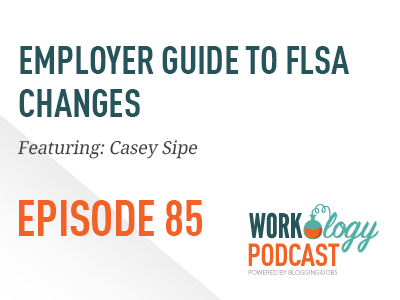The Department of Labor’s final rule on the updates regarding the Fair Labor Standards Act has arrived. Employers must begin following the new changes starting on December 1, 2016. This new announcement provides a much needed update surrounding four key areas: 1) Defining and Delimiting the Exemptions for Executives, 2) Administrative, 3) Professionals, and 4) Outside Sales and Computer Employees
Just to give everyone some background, the Department published a Notice of Proposed Rulemaking (NPRM) in the Federal Register on July 6, 2015 (80 FR 38515) and invited interested parties to submit written comments on the proposed rule by September 4, 2015. The Department received over 270,000 comments in response to the NPRM from a variety of interested stakeholders. The feedback the Department received helped shape the Final Rule. So let’s get down to discussing the final rule as outlined last week by the DOL.
Episode 85: What Employers Need to Know About the FLSA Changes with Casey Sipe (@CLSEMPLOYERLAW)
Employment lawyer, Casey Sipe breaks down some of the changes happening with the FLSA update and helps us understand their impact, including:
- Minimum salary requirements changing to $47,476 annually for a full time worker. That’s $913 per week, more than doubling the previous minimum salary requirement.
- The highly compensated employees exemption changing from $100,000 to $134,004.
Casey says these two salary changes are now tied to the 40th percentile of workers, with the numbers being updated every three years starting in 2020. The FLSA had not been updated since the 70s, but they are now committing to regular changes and updates every three years, starting in 2020. It’s a fun time to be in HR. Am I right?
How HR Can Help Implement FLSA Changes?
Casey cautions that HR should be most concerned about:
- Difficulty in implementing changes. Taking people from salary to hourly. They will have to start tracking their hours and will not be able to work off the clock. They can’t answer emails or work from home unless the employer wants to pay overtime.
- FLSA changes impact on employee morale. The times when employees saw their career progressing from hourly to salaried are changing. These employees might think they are being demoted back to being an hourly worker.
- Economic concerns. How are you going to fit these changes and what is going to work in your business.
Casey tells us that now is the time to take stock of your wage and hour procedures. It’s the perfect time to make changes, especially if employees have been improperly classified. Penalties for this include back pay for up to 3 years.
New FLSA regulations go into effect December 1, 2016. HR professionals have until this date to be in compliance. Use the time you have right now to get your house in order and figure out the best way to move employees from salaried to hourly, how to communicate it and to take a look at the bottom line.
Casey recommends a wage and hour audit and taking a public relations approach to your internal and employee communication. These FLSA changes are being positioned by the Obama administration as employees being able to earn more money. There is an expectation by experts of $5,000,000 in new overtime as a result of the FLSA Update.
As far as employer options, Casey says that companies can hire more people including part time, contract workers, or provide them with overtime pay. Which is the most cost effective option? You can find more information on the official ruling from the DOL in our resources below.
Connect with Casey Sipe on LinkedIn.
RECOMMENDED RESOURCES
HOW TO SUBSCRIBE TO THE WORKOLOGY PODCAST
*A special thank you to my production team at Total Picture Radio.









